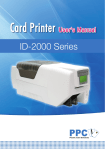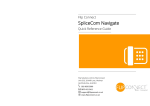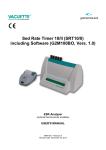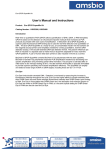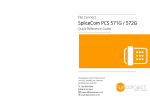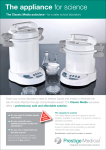Download HBV Quantitative Real-Time PCR Kit USER MANUAL
Transcript
For professional use only HBV Quantitative Real-Time PCR Kit (PREP-NA DNA/RNA Extraction Kit included) USER MANUAL "DNA-Technology, Research & Production" LLC Russia, 142281, Moscow Region, Protvino, 20 Zheleznodorozhnaya Street, Phone/fax:+7(495)980.45.55 +7(4967)31.06.70, E-mail: [email protected], [email protected] http://www.dna-technology.ru Q2-P602-23/9EU Q2-P602-S3/9EU Q2-P602-24/9EU 280.08.11.13 Table of contents 1. INTENDED USE 3 2. METHOD 3 3. CONTENT 4 4. REAGENTS AND EQUIPMENT REQUIRED BUT NOT PROVIDED 5 5. WARNINGS AND PRECAUTIONS 6 6. DNA EXTRACTION PROTOCOL 6 7. PCR PROTOCOL 8 8. CONTROLS 11 9. DATA ANALYSIS 12 10. TROUBLESHOOTING 13 11. STORAGE AND HANDLING REQUIREMENTS 13 12. SPECIFICATIONS 13 13. QUALITY CONTROL 14 14. KEY TO SYMBOLS 15 2 1. INTENDED USE The HBV Quantitative Real-Time PCR Kit is intended for research and diagnostic applications as well as for evaluation of the therapy efficacy. The HBV Quantitative Real-Time PCR Kit is an in vitro Nucleic Acid Test (NAT) – based pathogen detection and quantification product. The HBV Quantitative Real-Time PCR Kit is designed to detect and quantitate Hepatitis B Virus (HBV) nucleic acids in human blood plasma samples with an aid of Quantitative Real-Time Polymerase Chain Reaction (qPCR) method. The HBV Quantitative Real-Time PCR Kit can be used in clinical practice for HBV diagnostics. 2. METHOD The implemented PCR method is based on amplification of a target DNA sequence. The HBV Quantitative Real-Time PCR Kit is based on real-time detection of the target DNA sequence. Real-time PCR technology is based on measurement of the fluorescence at every cycle of reaction. The PCR-mix contains target-specific hydrolyzing probes bearing reporter and quencher molecules. Once hybridized to a target sequence, the probe become activated. As a result of activation fluorescence increases proportionally to target sequence amplification. The intensity of fluorescence is detected with a real-time PCR thermal cycler data collection unit and analyzed with the software provided. The assay includes following steps: -DNA extraction. On this step the internal control sample (IC) is added to the samples. It is needed for test quality assurance. -Real-time PCR amplification. The Kit has passed validation on “DNA-Technology” made instruments and software О-DTPRIME4M1-EU, О-DTPRIME5M1-EU, О-DTLITE4S1-EU, О-DTLITE5S1-EU. The HBV Quantitative Real-Time PCR Kits Q2-P602-23/9EU, Q2-P602-S3/9EU and Q2-P60224/9EU are also approved for use with iQ5 (Bio-Rad Laboratories) and Rotor-Gene (Qiagen) thermal cyclers respectively. The Kit can be supplied in either separate (1x96) or stripped (8x12) tubes. ( Q2-P602-23/9EU, Q2-P602-24/9EU and Q2-P602-S3/9EU respectively). -Quantitative analysis. The quantitation of the target DNA is performed with an aid of Standards (ST) with known concentration of artificially synthesized target DNA. The Kit supplied with STs of the two concentrations 1x106 (ST1) and 3x103 copies/ml (ST2). The STs are used to build the standard curve which is necessary to quantitate the DNA in the sample. 3 3. CONTENT Table 1. PREP-NA DNA/RNA Extraction Kit Reagent Description Total volume Amount Lysis buffer Colorless, soapy liquid 30 ml 1 vial Precipitation buffer Colorless liquid 40 ml 1 vial Washout solution 1 Colorless liquid 50 ml 1 vial Washout solution 2 Colorless liquid 30 ml 1 vial Dissolving buffer Colorless liquid 5 ml (1.25 ml in each tube) 4 tubes Negative control (C-) Colorless liquid 3 ml (1.5 ml in each tube) 2 tubes Internal control (IC) Colorless liquid 1 ml 1 tube Reagent Description Total volume Amount ST1 (1x106 copies/ml) Colorless liquid 75 µL 1 tube ST2 (3x103 copies/ml) Colorless liquid 75 µL 1 tube Table 2. Standards Table 3. HBV Quantitative Real-Time PCR Kit Reagent Description Total volume Amount Paraffin sealed PCR-mix Composition of colorless liquid and white waxy fractions 1.92 ml (0.02 µL per tube) 96 separate (1x96) or stripped (8x12) tubes TECHNO Taq-polymerase Colorless viscous liquid 50 µL 1 tube PCR-buffer Colorless liquid 1 ml (0.5 ml in each tube) 2 tubes Positive control (C+) Colorless liquid 150 µL 1 tube Mineral oil (not supplied in Kit for Rotor-Gene) Colorless viscous liquid 2 ml (1 ml in each tube) 2 tubes 4 The approximate total time needed to perform the assay is 4 hours The PREP-NA DNA/RNA Extraction Kit is sufficient for extraction of 100 samples. The HBV Quantitative Real-Time PCR Kit sufficient to test 44 samples in duplicates. 4. REAGENTS AND EQUIPMENT REQUIRED BUT NOT PROVIDED 4.1 Specimen collection The whole blood samples shoud be collected in 2 or 4 ml Vacuette type tubes with EDTA in 2.0 mg/ml final concentration. The sodium citrate anticoagulant is also applicable. The use of heparin anticoagulant is not allowed. 4.2 DNA extraction and PCR Vortex mixer Vacuum pump with collector to remove the supernatants 1.5 ml tubes PCR tube rack for 0.2, and 1.5 ml tubes Single channel pipettes (volume range 0.5-10 µL, 5-40 µL, 40-200 µL, 100-1000 µL) RNase and DNase free filtered pipette tips (volume range 20 µL, 50 µL, 200 µL, 1000 µL) Powder-free surgical gloves Disinfectant solution Container for used pipette tips High speed centrifuge (13000 rpm) Thermostat (temperature range 50-65°C) Refrigerator Real-time PCR thermal cycler 5 5. WARNINGS AND PRECAUTIONS The laboratory makeup should comply the requirements regulating work with microorganisms of I-IV classes of pathogenicity. Handle and dispose all biological samples, reagents and materials used to carry out the assay as if they were able to transmit infective agents. Avoid direct contact with the biological samples reagents and materials used to carry out the assay. Any material coming in contact with the biological samples must be treated for at least 30 minutes with disinfecting solution or autoclaved for 1 hour at 121ºC before disposal. Molecular biology procedures, such as nucleic acids extraction, reverse transcription, amplification and detection require qualified staff to avoid the risk of erroneous results, especially due to the degradation of nucleic acids contained in the samples or sample contamination by amplification products. All oligonucleotide components are produced by artificial synthesis technology according to internal quality control protocol and do not contain blood or products of blood processing. Positive control is produced by artificial DNA synthesis technology. Positive control does not include parts of infectious agents. All the liquid solutions are designed for single use and can not be used more than once in amplification reactions. Plastic tubes do not contain phthalates. Do not breathe gas/fumes/vapour/spray produced by the components of the kit. Do not eat/drink components of the kit. Avoid contact with eyes. Do not use the kit after the expiry date provided. Only use the reagents provided in the kit and those recommended by manufacturer. Do not mix reagents from different batches. Do not use reagents from third party manufacturers’ kits. Significant health effects are NOT anticipated from routine use of this kit when adhering to the instructions listed in the current manual. 6. DNA EXTRACTION PROTOCOL The HBV Quantitative Real-Time PCR Kit is designed to detect DNA extracted from whole blood. Shake the tube containing blood sample thoroughly to mix the blood and anticoagulant. The overall storage of the sample should not exceed 6 hours. The transportation and storage temperature from collecting the sample till analysis should be in 2-4°С range. 6.1 To obtain the plasma spin the tubes with blood at 3000 rpm for 20 min at room temperature (18–25°С). 6.2 Take the upper fraction (plasma) with an automatic sampler and put it into the new 1.5 ml tube. The blood plasma can be stored at -20°С for 3 months. The lysis buffer can contain the precipitate. Dissolve it at 65°С for 10 min. prior to use. 6 At this step of assay use only RNase and DNase free pipette tips. To rise the reliability of the results it is advised to perform the extraction in duplicates. 6.3 Mark the required number of 1,5 ml tubes by the following scheme: - 2 tubes for each sample to be tested - 1 tube for the negative control (C-) - 1 tube for the positive control (C+) For example if you need to test 10 samples, mark 22 tubes (20 for the samples, 1 for C- and 1 for C+). 6.4 6.5 Add 10 µL of the premixed IC in each tube. Add 300 µL of the lysis buffer avoiding contact of the pipette tip with an edge of the tube. Close the tubes. Open the tube, add sample, then close the tube before proceeding to the next DNA sample to prevent contamination. 6.6 6.7 6.8 Add 100 µL of the blood plasma sample into the marked tubes. Do not add samples to the C- and C+ tubes. Add 100 µL of the C- and C+ into corresponding tubes. Close the tubes and mix them for 3–5 s twice. 6.9 Incubate the tubes for 15 min at 65°С, spin down the drops at 13000 rpm for 30 s at room temperature (18–25°С). 6.10 Add 400 µL of the precipitation buffer into all tubes. Close the tubes and mix them for 3– 5 s. twice. 6.11 Spin the tubes at 13000 rpm for 15 min at room temperature (18–25°С). 6.12 Remove the supernatant avoiding contact of the pipette tip with the precipitate. Use new tip for each sample. 6.13 Add 500 µL of the washout solution №1 to the precipitate and shake the tube thoroughly 6.14 Spin the tubes at 13000 rpm for 5 min at room temperature (18–25°С). 6.15 Remove the supernatant avoiding contact of the pipette tip with the precipitate. Use new tip for each sample. 6.16 Add 300 µL of the washout solution №2 to the precipitate and shake the tube thoroughly. 6.17 Spin the tubes at 13000 rpm for 5 min at room temperature (18–25°С). 6.18 Remove the supernatant avoiding contact of the pipette tip with the precipitate. Use new tip for each sample. 6.19 Open the tubes and dry the precipitate at 65°С for 5 min. 6.20 Add 25 µL of the dissolving buffer to the precipitate. Spin down the drops for 3–5 s. 6.21 Incubate the tubes for 10 min at 65°С. 7 6.22 Spin down the drops at 13000 rpm for 30 s. The nucleic acid preparation is ready. The preparation can be stored at -20°С for 1 month or at -70 °С for 1 year. 7. PCR PROTOCOL 7.1 Mark tubes with PCR-mix for each test sample, negative control (C-), positive control (C+) and three tubes for each of the Standards (ST1 and ST2). For example if you need to test 10 samples, mark 28 tubes (20 for each sample in duplicate, 1 for C-, 1 for C+, 3 for ST1 and 3 for ST2). Mark only the caps of the tubes when using Rotor-Gene Thermal Cycler. 7.2 7.3 Thaw PCR-buffer at the room temperature Mix the PCR-buffer and TECHNO Taq-polymerase thoroughly (3-5 sec), then spin briefly (13 sec) at room temperature (18–25°С). Hold TECHNO Taq-polymerase at room temperature as short time as possible. The overheating is detrimental to its performance. 7.4 Prepare the mixture of PCR-buffer and TECHNO Taq-polymerase (TECHNO Taq-polymerase solution). Add into the one tube: 10 х (N+1) µL of PCR-buffer, 0,5 × (N+1) µL of TECHNO Taq-polymerase, 7.5 7.6 7.7 N — number of the marked tubes including C-, C+, ST1 and ST2 Vortex the tube with TECHNO Taq-polymerase solution for 3-5 seconds and spin down the drops for 1-3 seconds at room temperature (18–25°С). The maximum storage time for TECHNO Taq-polymerase solution is 1 hour. Add 10 µL of TECHNO Taq-polymerase solution into each tube. Avoid paraffin layer break. 7.8 Add 20 µL of mineral oil into each tube. Avoid paraffin layer break (skip this step when using Q2-P602-24/9EU). Close the tubes. Vortex the tubes with samples for 3-5 seconds and spin down the drops for 1-3 seconds. 7.9 Add 5,0 µL of DNA sample into corresponding tube. Avoid paraffin layer break. Open the tube, add DNA sample, then close the tube before proceeding to the next DNA sample to prevent contamination. Use filter tips. 7.10 Add 5,0 µL of C-, C+, ST1 and ST2 into corresponding tubes. Avoid paraffin layer break. 7.11 Spin tubes briefly (1-3 sec). 7.12 Set the tubes to Real-Time PCR Termal Cycler. 7.13 Launch the Thermal Cycler software and run PCR according to instructions supplied with device. See table 4-7 to refer the cycling program an table 8 to refer the detection channels. 8 Table 4. The PCR program for DTlite and DTprime Thermal Cyclers Step 1 2 5 Temperature, °C Min. Sec. 94 94 62 10 5 0 0 … 00 10 20 … Number of cycles Optical measurement 1 Type of the step Cycle 50 v … Cycle Holding Table 5. The PCR program for iCycler iQ5 thermal cyclers (with persistent well factor) Cycle Repeats 1 1 2 50 3 4 1 … PCR/Melt Data Acquisition Step Dwell time Setpoint, ºC 1 5 min 94 1 2 10 sec 20 sec 94 62 Real Time 10 Storage … Table 6. The PCR program for iCycler iQ5 thermal cyclers (with dynamic factor) Cycle Repeats Step Dwell time Setpoint, ºC PCR/Melt Data Acquisition dynamicwf.tmo program 1 2 3 4 5 1 1 2 00:30 05:00 80,0 94,0 1 2 00:20 00:30 94,0 62,0 1 00:20 PCR program 80,0 Real Time 1 2 … 00:10 00:20 … 94,0 62,0 10,0 Real Time Storage 5 2 45 9 Table 7. The PCR program for Rotor-Gene Thermal Cyclers Cycling Temperature Hold Time Cycle Repeats Cycling 80 °C 300 sec 1 time 94 °C 10 sec 58 °C 5 sec 62 °C* 25 sec Cycling 2 50 times * Take the measurement Table 8. Detection channels Specific product IC DTprime, DTlite and IQ5 FAM HEX Rotor-Gene Green Yellow 8. CONTROLS Table 9 Result Control The controlled step C+ PCR C- IC PCR and DNA extraction PCR DNA extraction Specific signal is present Specific signal is absent Interpretation + + Valid - - Invalid + + Invalid - - Valid + + Valid - Valid - Invalid 10 The sample is considered positive if the signal for specific DNA is present. The signal for IC could be absent in samples with high concentration of specific DNA due to competitive priming. The sample is considered negative if the signal for specific DNA is absent and for IC is present. If the signal for C- is present, whole tests of current batch considered false. Decontamination required. 9. DATA ANALYSIS The analysis performed automatically. After completion of the run the device will build standard curve, define the concentration of viral DNA and form the report. The PCR efficiency should be in 90-100% range. The interpretation should be performed in accordance with table 10. Table 10 Detection channel Fam/Green copies/ml Hex/Yellow Cp (Ct) Interpretation Test samples 7,5x102 – 1,0х108 Not considered Positive with specified viral load (copies/ml) Less than 7,5x102 Not considered Positive with notification «Less than 750 copies/ml» (no specified value) More than 1,0х10 Not considered Positive with notification «More than 1,0х108 copies/ml» (no specified value) Not specified (N/A) Specified (Cp/Ct 29-34) Negative 8 Not specified (N/A) Not specified (N/A) Uncertain C+ 2,2×104 – 7,1×104 * Not considered Positive with specified viral load (copies/ml) CNot specified Specified (Cp/Ct 29-34) Negative *If the concentration of the C+ falls out the 2,2×104–7,1×104 range the test should be repeated 11 10 TROUBLESHOOTING Table 11 Specific signal + C+ - Specific signal - Possible cause Solution Operation error Repeat whole test PCR inhibition - Violation of storage and handling requirements Dispose current batch Dispose current batch C- + IC + Contamination Perform decontamination procedures - PCR inhibition Repeat whole test 11 STORAGE AND HANDLING REQUIREMENTS Expiry date – 6 month from the date of production. All components of the HBV Quantitative Real-Time PCR Kit (except PCR-mix, ST1, ST2 and C+) must be stored at -20°C over the storage period. The PCR-buffer and mineral oil can be stored at at 2-8°C. The PCR-mix, ST1, ST2, C+ and PREP-NA DNA/RNA Extraction Kit must be stored at 2-8°C over the storage period. Transportation can be held by all types of roofed transport with adherence to above mentioned temperature requirements. An expired HBV Quantitative Real-Time PCR Kit must not be used. We strongly recommend following the instructions to get robust and reliable results. The conformity of the HBV Quantitative Real-Time PCR Kit to the prescribed technical requirements is subject to compliance of storage, carriage and handling conditions recommended by manufacturer. Contact our customer service by quality issues of the HBV Quantitative Real-Time PCR Kit: 115587, Moscow, Varshavskoye sh. 125g building 6, DNA Technology, LLC. Phone/Fax: +7(495)9804555 e-mail: [email protected], www.dna-technology.ru 12 SPECIFICATIONS a. Analytical specificity: the HBV Quantitative Real-Time PCR Kit allows detection of all known HBV subtypes. The samples containing HBV will be defined as positive and characterized quantitatively. The samples not containing HBV will be defined as negative. 12 b. Linear range: 7,5x102 – 1x108 copies/ml c. Variation coefficient: less than 7% d. Sensitivity: not less than 200 copies of HBV DNA per 1 ml of blood plasma. The claimed specifications are guaranteed when DNA extraction is performed with PREP-NA DNA/RNA Extraction Kit. 13 QUALITY CONTROL “DNA-Technology, Research&Production” LLC declares that. the quality control procedures performed in accordance with ISO ISO 9001:2008 and ISO 13485:2003 13 14 KEY TO SYMBOLS Caution Manufacturer Consult instructions for use Negative control Date of manufacture Positive control Expiration date Cataloque number In vitro diagnostic medical device Sufficient for Batch code Temperature limitation Version Upper limit of temperature 14 15 16
















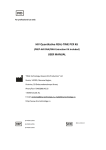

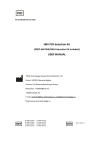


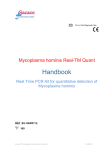
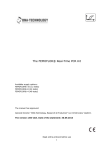
![[ENG] – User Manual – Hammer 2](http://vs1.manualzilla.com/store/data/005660577_1-e32ef60d54b8720b57dfb511ee785652-150x150.png)
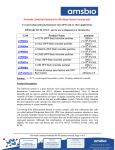

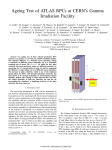
![[ENG] – User Manual – Hammer 2+](http://vs1.manualzilla.com/store/data/005819402_1-dfa23d20e4e51293175fe8e87aea0a77-150x150.png)
